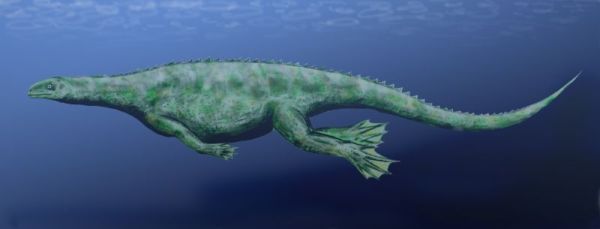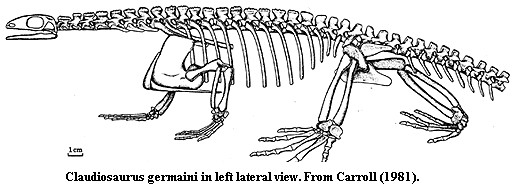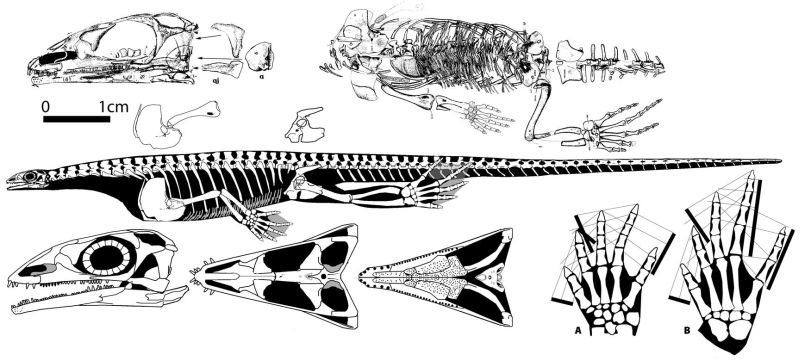
Claudiosaurus germaini, an aquatic neodiapsid from the Tangasaur from the Late Permian (Sakamena Formation) of Madagascar.. illustration by Nobu Tamura (Wikipedia)
| Diapsida | ||
| The Vertebrates | Claudiosaurus |
| Vertebrates Home | Vertebrate | Vertebrate |
|
Abbreviated Dendrogram
Amniota
├─Synapsida
└─Sauropsida
├─Anapsida
╘═Eureptilia
│
└─Diapsida
╞═Araeoscelida
└─Neodiapsida
╞═"Younginiformes"
└─┬─Claudiosaurus
├─Weigeltisauridae
└─┬─┬─┬?─Thalattosauria
│ │ └?─Saurosphargidae
│ └─Ichthyosauria
├?─Omphalosaurus
├?─Hupehsuchia
└─Sauria
├?─Choristodera
├─Lepidosauromorpha
└─Archosauromorpha |
Contents
Overview |
 Claudiosaurus germaini, an aquatic neodiapsid from the Tangasaur from the Late Permian (Sakamena Formation) of Madagascar.. illustration by Nobu Tamura (Wikipedia) |
Claudiosaurus was a medium-sized 60 cm) low-slung reptile with a small head, fairly long neck, and a long tail. It lived by the shores of lakes or sheltered seas along a pair of rift valleys in what is now Madagascar in the Late Permian -- just before whatever event(s) it was that killed off most life forms on Earth at the end of the Paleozoic. As discussed elsewhere, many of the basal diapsids are rather scrappy; and this has led to some rather odd phylogenies. Claudiosaurus is an exception. It is well known from a number of good specimens. Even better, it seems rather clear that, as Carroll (1981) pointed out in his original description, Claudiosaurus is closely related to a group of neodiapsids now known as the Younginiforms.
 Claudiosaurus was almost certainly amphibious. Caldwell 1994). This is not really obvious from a first glance at the skeleton, but has been quite convincingly shown by Carroll and Caldwell. Its most enigmatic feature is the skull. As in snakes, there seems almost nothing holding the skull together. The lower temporal bar is completely absent, the post-orbital skull is full of large holes, and the pre-orbital skull was weakly bound and may not even be completely ossified. It is hard to make sense of all the data, but at least there is no lack of data to make sense of.
Claudiosaurus was almost certainly amphibious. Caldwell 1994). This is not really obvious from a first glance at the skeleton, but has been quite convincingly shown by Carroll and Caldwell. Its most enigmatic feature is the skull. As in snakes, there seems almost nothing holding the skull together. The lower temporal bar is completely absent, the post-orbital skull is full of large holes, and the pre-orbital skull was weakly bound and may not even be completely ossified. It is hard to make sense of all the data, but at least there is no lack of data to make sense of.
In spite of this wealth of information, it has proven no easier to get an exact placement for Claudiosaurus than it has been for Paliguana. Most of the confusion may be due, in addition to the inclusion of taphonomic detritus, to inconsistencies in nomenclature. The most logical definitional benchmark in this area is clearly that of Jacques Gauthier. The benchmark clade is the crown group Sauria = the last common ancestor of birds and snakes. Then Lepidosauromorpha = all Saurians closer to snakes than birds; and Archosauromorpha = all Saurians closer to birds than snakes. "Closer" in this parlance means "having a more recent common ancestor with." We can't use a "diapsid" benchmark because the diapsid condition is a physical character. It has no phylogenetic meaning. We can't really use Reptilia (= turtles + turtledoves) because of the continuing concern that turtles might turn out to be inside Sauria after all. Thus, if our discussions are to be tied to reality at all, it is quite important that the Saurian anchor be firmly in place. In spite of this logical necessity, many phylogenies -- including, until recently, these Notes -- have allowed each member of this crown-stem triad (see Sereno (1998)) to live a wild, free life of its own. See, e.g. Caldwell 1996); Motani et al. 1998) and (to a far lesser extent) deBraga & Rieppel (1997).
Interestingly, when we apply a consistent nomenclature and simply remove the uncertain bits and pieces, everyone's cladogram looks like this:
The only genuinely unsettled points are (a) whether turtles are in this mix somewhere and (b) the position of the Coelurosauravidae. The latter have variously been placed between Claudiosaurus and the Younginiformes, or as a sister to Ichthyosauria. (I have chosen the former alternative for no particular reason.) In truth, the original results of Caldwell (1994) are not quite consistent with this scheme, but Motani et al. 1998) do obtain this pattern with the same data set when they recode Ichthyosauria to incorporate more recent information. ATW010415
Late Permian of Madagascar.
Neodiapsida: (Coelurosauravidae + (Younginiformes + (Ichthyopterygia + Sauria))) + *.
About 60cm. Head small; ~50 small, sharp marginal teeth none procumbent); shagreen of denticles on palatal bones; Meckelian canal partly open; transverse pterygoid flange undifferentiated and weak; interpterygoid vacuities reduced or absent; small suborbital fenestra present; anterior skull poorly known; premaxillae with long, thin nasal process; nasals large; prefrontal (?) large; lacrimal is an odd, oval element probably excluded from orbit; orbit large; large upper temporal fenestra; lower temporal bar and posterior process of jugal absent; quadrate strongly supported by pterygoid unlike squamates); stapes unknown (?); no stapedial foramen on quadrate; posterior margin of parietal sculpted and may have supported postparietals, tabulars, etc.; long neck (from posterior displacement of pectoral girdle?), with 8 cervical vertebrae; 25 presacral vertebrae, all except atlas with ribs; dorsal centra ~twice as long as wide; intercentra present; neural arches in trunk well-developed and articulate; rib cage probably complete (in cartilage); ribs not pachyostotic; 2 sacral vertebrae with partial incorporation of a 3rd; tail slender & not specialized for aquatic locomotion; caudal vertebrae not specialized; sternum not ossified but clearly present; scapulocoracoid ossified as single plate-like units, forming complete plate with large interclavicle; glenoid quite far posterior and angled posteriorly; digit 3 is longest on manus; ilium elongated; no thyroid fenestra; calcaneum with distinct lateral flange gastrocnemius?); some indication that proximal and distal tarsals were partially locked together; lateral centrale reaching fourth distal tarsal. Amphibious?
Links: Icarito Interactivo - dinosaurios (Spanish); Autapomorphies of diapsid clades, Wikipedia (stubby), UCMP - Basal Diapsids (only a paragraph), .
Note: determinate growth of long bones, but ossification of distal limb and some cranial bones continued throughout life. Carroll (1981) makes a fairly good case that Claudiosaurus was a derived relative of Thadeosaurus, now classified as a younginiform.
 Illustration of skeleton of Claudiosaurus germaini, by David Peters, Reptile Evolution. |
checked ATW050512, new page MAK111116
Using this material. All material by ATW is public domain and may be freely used in any way (also any material jointly written by ATW and MAK). All material by MAK is licensed Creative Commons Attribution License Version 3.0, and may be freely used provided acknowedgement is given. All Wikipedia material is either Gnu Open Source or Creative Commons (see original Wikipedia page for details). Other graphics are copyright their respective owners